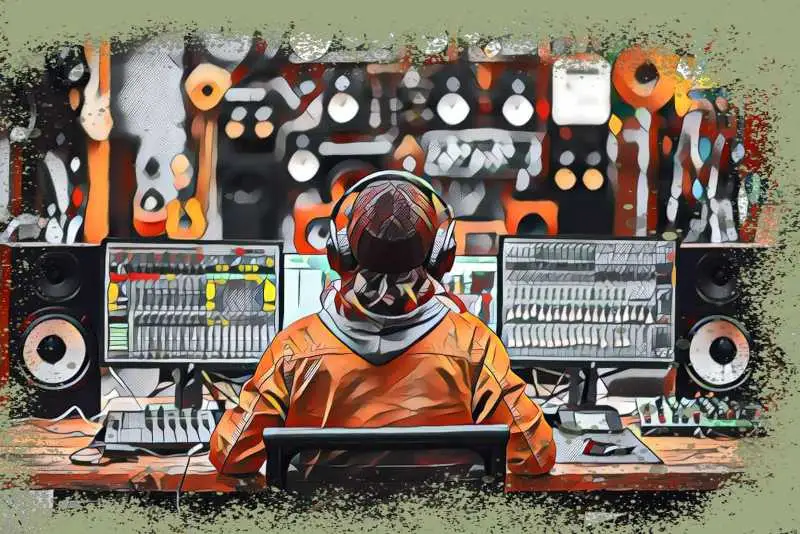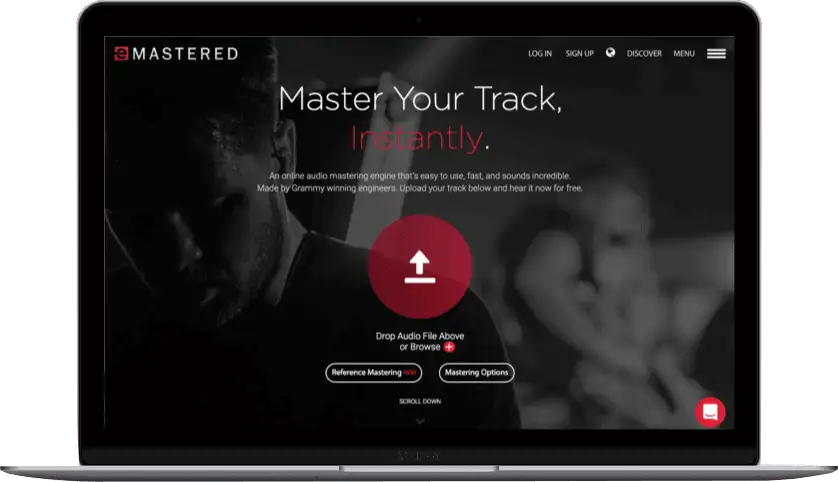Ever wondered how your favorite songs were made? Or perhaps you want to create your own music?
Whether you're dreaming of producing music for other artists, composing music for media , or just want to understand how the musical sausage gets made, this step by step guide has got you covered.
We'll be walking you through the entire process, including a breakdown of gear you need, songwriting and composition techniques, and the technical aspects of producing music.
Music production is a wild and fun world of plugins, software, hardware, skill, and creativity. But all you really need is a laptop and a dream.
And this guide.
Every music producer starts somewhere. This is where you begin.
Music Production Part 1: Equipment and Skills
Music Production Basics
The phrase ‘producing music’ is a deceptively simple way of describing a whole range of activities that make up the music production process.
Here’s a super-basic breakdown of what producing music can involve:
Writing & Arranging
Before any music can be recorded, you’ll need to actually write the song. Granted, there are many producers who write tracks as they produce them - building a beat, creating a chord progression, adding a bass line, and so on.
When you write songs, it’s more important to write ahead of going into the studio, since lyrics are such an important part of the song.
Either way, at some point the music and lyrics need to be written, and it'll need organizing into a coherent structure - arranging the song.
Not every music producer gets involved in writing the songs, especially when they predominantly work with artists, rather than for themselves.
Programming & Sound Design
Depending on the style of music you're producing, there may be an element of programming in the production process. This can include programming beats and bass parts, or creating different sounds using synths and plugins.
Some genres lean more heavily into this process than others. Electronic music, for instance, involves more programming than producing a rock band. The more 'in the box' you are, the more programming you'll do.
Recording
Recording vocals or 'real' instruments is an important aspect of music production. If you're working with other musicians and singers, the role of a producer involves coaxing the best performances out of everyone as they record. For this, you'll need exceptional people skills!
Mixing & Mastering
Once everything's recorded and programmed, the track will need mixing and mastering. Some producers will handle one or both of these themselves, while others will farm it out to a dedicated mixing and/or mastering engineer.
What Does a Music Producer Do?
Where does a music producer fit into all of this? Well, that depends. Many musicians produce their own music, taking on the role of songwriter, artist, and producer. Famous examples include Chance the Rapper, British grime artist Skepta, and Pharrell Williams.
Other music producers collaborate with artists to help shape their sound. This may involve simply zhuzh-ing up an arrangement in the studio and coaxing the best performances out of the musicians they record, or participating more deeply in the music creation process. George Martin was commonly referred to as the ‘fifth Beatle’ because he was so heavily involved in the Beatles’ creative process.
A successful music producer will be skilled at all of the above, but know where they fit into the picture and how they can best serve the music.
Tools & Equipment
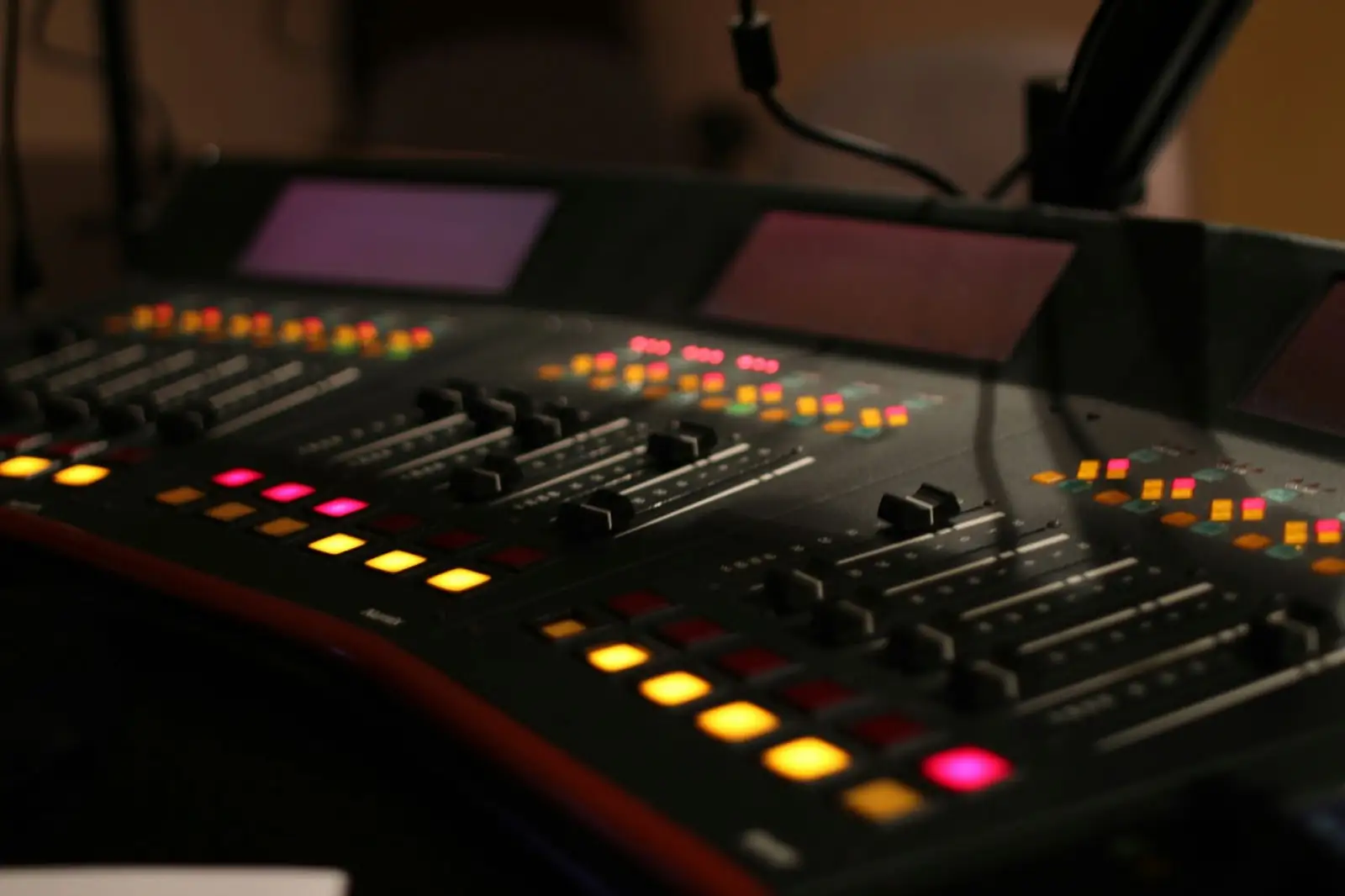
Whether you're producing your own songs or collaborating with other artists, you'll need some basic gear to get started. Granted, you could book time in a recording studio with all the tools already in place, but that gets expensive fast, especially when you're just beginning your music production journey.
The good news is that you can build a surprisingly capable home studio setup without breaking the bank (or your parent's credit card). Let's take a look at the essential tools and equipment you'll need to start making music from the comfort of your own space.
Computer
The first thing you'll need is something you probably already have - a computer. Whether it's Mac or Windows OS it'll be the beating heart of your studio. Ideally, you want high-performance processors, plenty of RAM, and an SSD drive, for everything to run smoothly.
Digital Audio Workstation
A DAW (digital audio workstation) is the command HQ for a professional music producer. It's where everything happens - instruments are recorded, synths are programmed, melodies are turned into tracks, etc. In short, it's a music producer's primary tool.
There are a ton of fantastic digital audio workstation options to suit every budget :
- Reaper
- Logic Pro
- Ableton Live
- FL Studio
- Cubase
- Pro Tools
- PreSonus Studio One
While they all have different features, they essentially all do the same thing - capture the music you create.
Audio Interface
An audio interface ships analog signals into the digital world, and vice-versa. If you're recording any kind of external source into your DAW, like vocals, guitar etc. you'll need one .
Some audio interfaces also offer further connectivity options, such as MIDI and digital audio ; essential if you want to hook MIDI or analog hardware into your system.
Finally, an audio interface will provide outputs for connecting studio monitors and headphones (sometimes multiple sets), allowing you to hear your masterpiece in all it's sonic glory. Speaking of which...
Monitors & Headphones
You'll need something to listen to your self-created music on. Air pods or consumer grade speakers aren't going to cut the mustard here; they color the sound to make it pleasant to the ear.
What you need are dedicated home studio monitors and headphones that offer an accurate representation of what's coming out of your DAW, warts and all. You'll need them for monitoring as you record tracks, and later on in the production process too.
MIDI Controller
Whatever kind of music you make it's worth having a MIDI controller as part of your set-up. They come in all shapes and sizes , and with different features, but even a simple little keyboard controller will enable you to input notes quickly and easily.
MIDI controllers often come with pads, buttons, and knobs that make playing drum patterns or controlling other MIDI parameters more musical. Some even have faders to help with mixing workflow.
Samples, Software Instruments, & Effects
Unless you're recording Gregorian Chants in a church, you'll need some plugins to process your sounds. From basic effects like reverb and delay , to more complicated processing like granular sound synthesis and side chain compression , these plugins will help you craft a unique sound, and help make your mix sound professional.
Luckily, most DAWs ship with stock instruments and effects that will get the job done nicely, so there's no need to splurge on software right off the bat.
Microphone
Finally, if you're planning to record vocals (or any other type of acoustic instrument) in your home studio you'll need a decent quality microphone. Be sure to choose one that works well for the types of sound sources you'll be recording.
Comfortable Chair and Desk
While not completely essential, having a chair and desk combo that's comfortable to work at for hours at a time while you're composing music will boost your productivity. What can I say? I like being comfortable when I produce.
Music Producer Skills
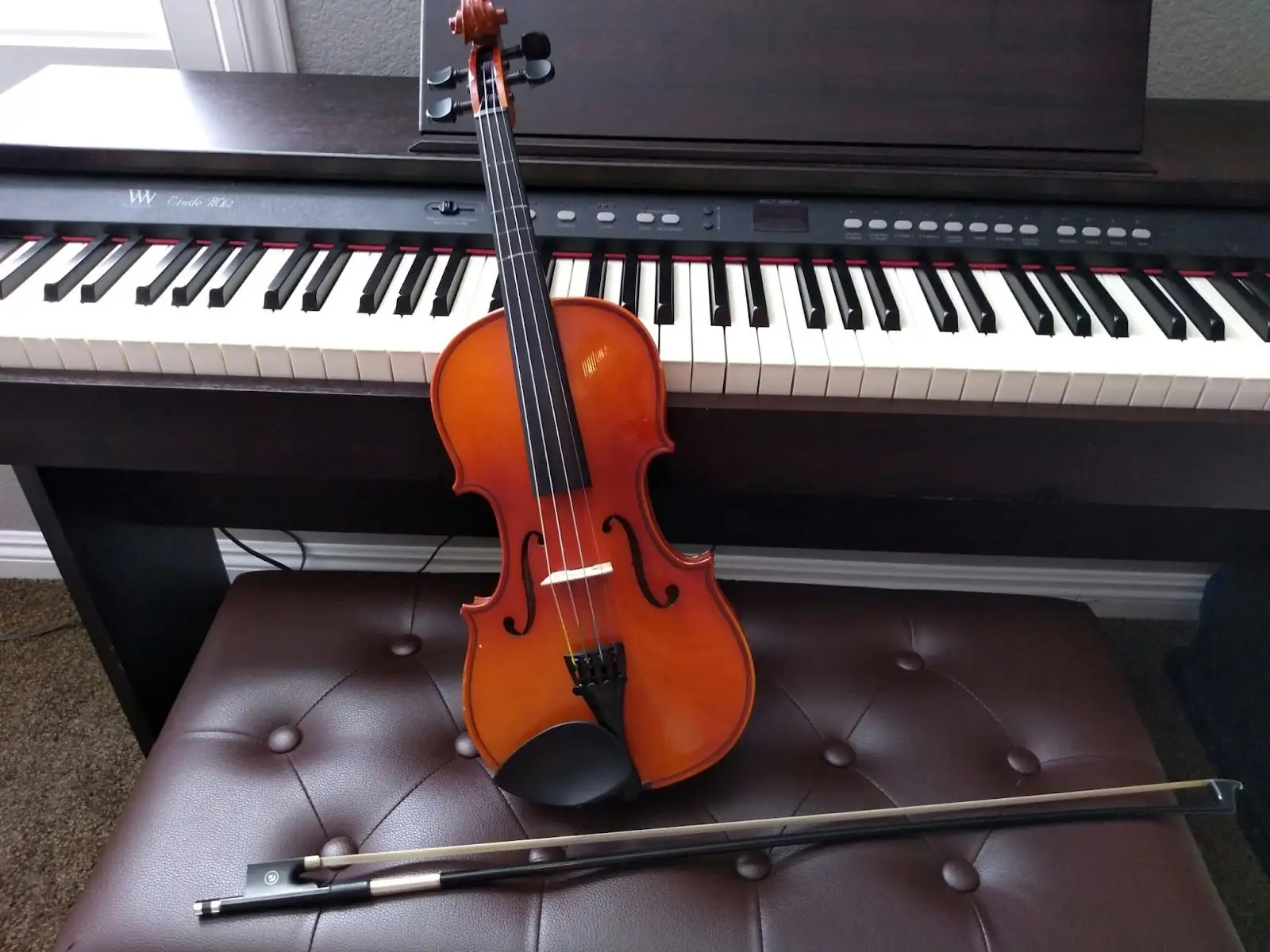
Yes, you can go to college to study music production, but the cost adds up. Many producers are self-taught, and most music production techniques can be learnt from online courses, watching videos online, or working through tutorials on websites or in magazines.
There are a few, less-obvious skills however, that will help you become a better producer.
Music Theory
Well, maybe this is an obvious one. But the more you understand about how music works , the better you'll be at producing it; you'll instinctively know why something isn't working musically, and how to fix it.
Plus, if you're working with other musicians it'll help you communicate more effectively with them. On that note...
People Skills
Communication is probably the most important part of being a producer. From networking in the music industry to collaborating with other artists, being able to put people at ease is an essential skill.
Listening Skills
Everybody listens to music. But a music producer listens differently.
Active listening means tuning into the details; analyzing melodies, breaking down arrangements, figuring out what's happening in the mix, and spotting techniques used in the most popular songs. It also means keeping an ear out for shifts in style, sound, and structure that reflect current industry trends.
Developing this kind of focused listening is one of the most valuable skills you can build as a music producer, and it all gets sharper with practice.
Project Management
It might sound like something out of a corporate handbook, but project management is a big part of being a music producer, especially if you're producing a whole album with a band, or working on a collaborative project.
You'll need to stay on top of things like file management, session scheduling, booking musicians, and keeping an eye on the budget (yes, even a music producer can't escape a spreadsheet).
It also helps to have a basic understanding of how music industry contracts work. Dealing with session players , licensing , or royalties isn't the flashiest part of record production, but definitely one of the most important if you want to run a smooth, professional production ship.
Music Production Part 2: Techniques and Strategies
Songwriting and Composition Techniques
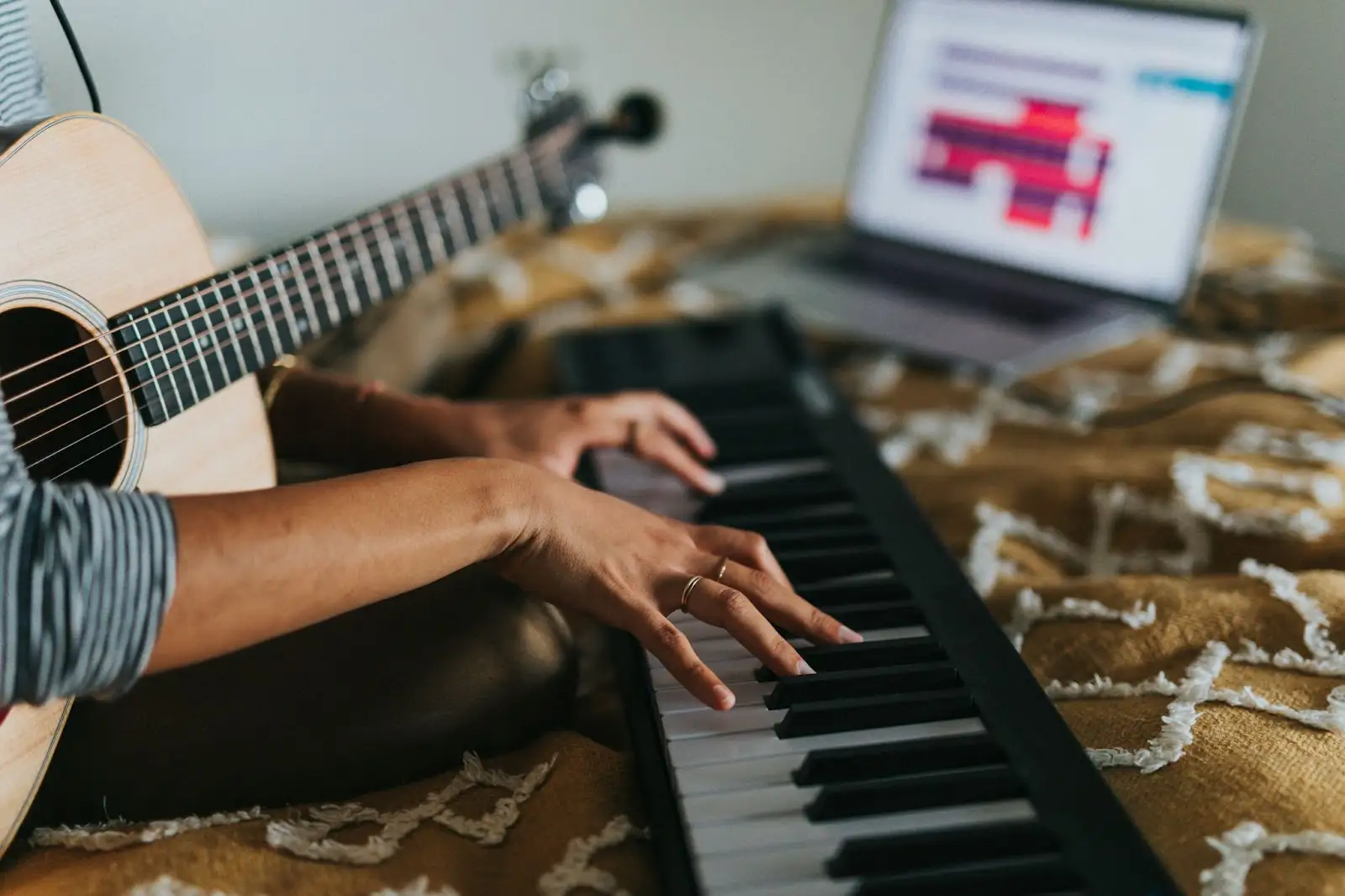
Starting Points
There's nothing worse than staring at a blank screen, wanting to write music, but not knowing where to start. Part of the problem is that there are a lot of ways you can start a song.
Build a Beat
Kicking things off with a groove can be a great way to start a song - it sets the energy and pace, and in some genres drives all the other instruments. Digital audio workstations like FL Studio and Ableton Live make conjuring up beats simple and easy.
Create a Chord Progression
If you're after something more vibey, try starting out with a chord progression . Even something simple can get the ball rolling, and once you've started you can switch out chords to create something more unique.
Choose a Song Structure
Having a road map of how your song will progress can help keep you focused, especially when writing lyrics.
Write Some Lyrics
If music isn't forthcoming, try starting out with lyrics instead. A strong lyrical hook could suggest a rhythm that will become the foundation of a song.
Throw Some Loops Together
Sometimes it's good to just play around with ideas. Try throwing a bunch of loops into a project to get a mood going. They can be audio- or MIDI-based - anything to kick-start your creativity. Oftentimes you'll find a snippet of a musical idea hidden somewhere in there, and that nugget will lead you into new creative territory.
Noodle Around
You don't have to be a virtuoso piano or guitar player to make this work. Simply find a sound you like, hit record, and start to play. Explore, make mistakes, and delve into territory you've not visited before. Most of all, don't edit yourself; just play.
Keep It Simple
Yes, knowing music theory helps when producing music, but you don't need a degree in music to write songs.
So many popular songs rely on very basic three- or four- chord progressions. Often the verse and chorus will use the same progression under a different melody, and with different instrumentation. You don't need to explore every harmonic possibility if you find one thing that works well.
The same applies to melodies; they're often more effective when they are short, singable, and rhythmically interesting.
Don't try to reinvent the wheel; when you find a musical idea that floats your boat, run with it. After all, the emotion behind the song is what will draw the listeners in.
Learn From Others
There are a lot of songs in the world. Some good, some bad, some indifferent (I'm looking at you, Nickelback). But love 'em or hate 'em, a lot can be learned when you actively listen to songs. Start with your favorite tracks;
- What's the song structure?
- How does the chord progression move?
- What's the shape of the melody?
- How does the tempo affect the emotional qualities?
I'm not saying copy your favorite song; rather, learn what it is about it that moves you by studying all the inherent parts.
The same applies for the instrumentation, arrangement and production techniques. The more you engage in this learning process and absorb music from other genres (particularly those you don't often listen to), the richer your own musical style will be.
Start Making Music
There's no hard-and-fast rule as to how you should start a song; the main thing is that you start, and keep starting. Save everything, even the half-baked cr*ppy noodle you knocked out after a night on the town. You can always come back later and build on it.
Starting Your First Project
So. You've gathered all the tools you need, and you're ready to start producing your first track. Oo-err, missus. Music production takes a lifetime to master, and the best way to learn is by just doing it .
Let's take a step by step walkthrough of what music production actually looks like. This isn't the only way to do it; it's just one way to do it. I'm using Logic Pro for this walk-through, but you can recreate the steps in pretty much any DAW.
Before We Begin
I'm a stickler for organization. It helps keep things in order when you're working on multiple projects at the same time. To that end, create a master folder on your hard drive where you'll store all your current projects (you can archive projects to an external HD when they're finished).
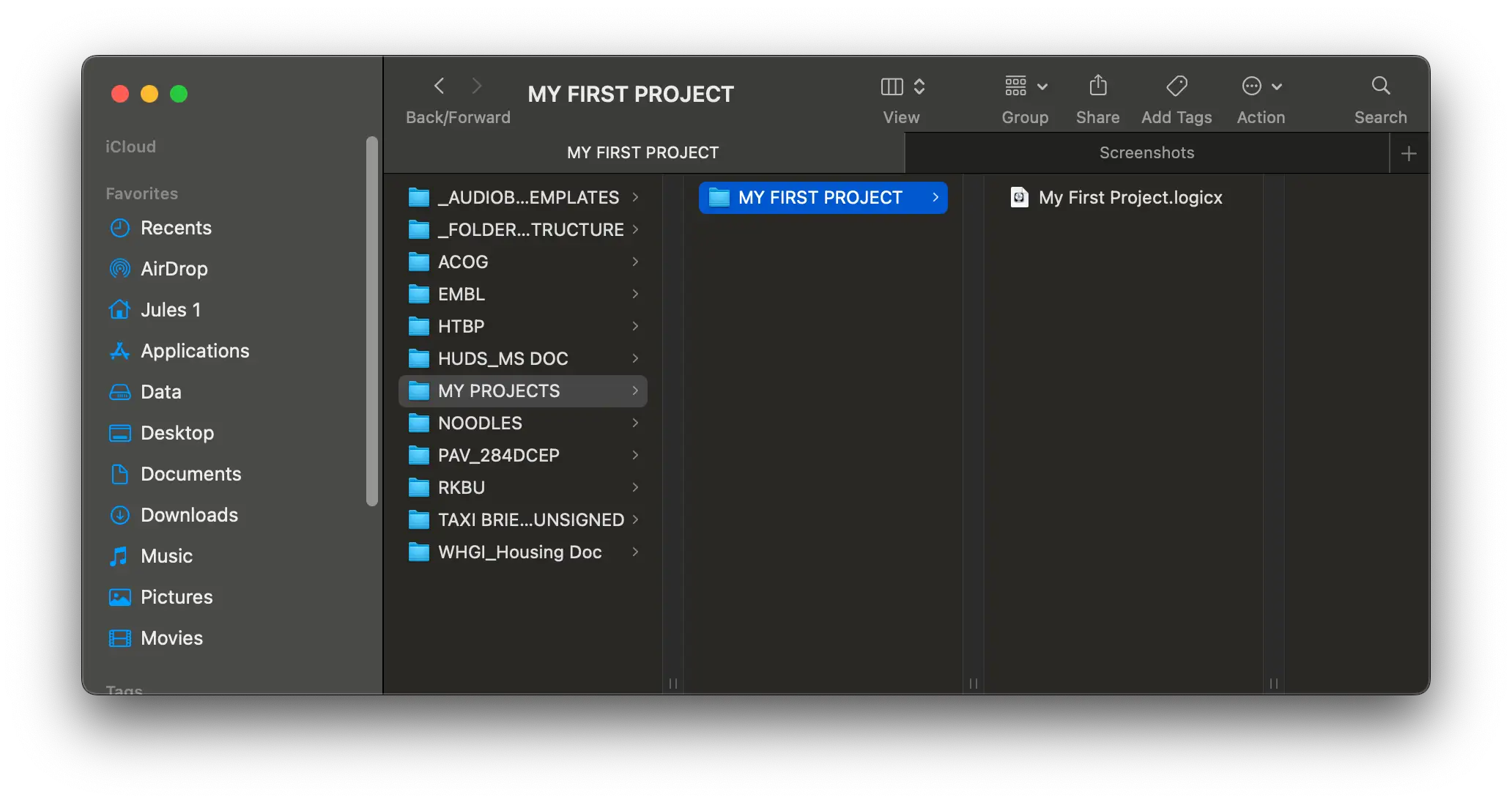
Then create a sub-folder for each project you're currently working on. Once you've opened your session, immediately 'Save As' and give it a name. That way you can save your progress as you go with a quick Ctrl+S/Command+S , rather than get lost in the music and lose all your work with a system crash (been there, done that).
OK, housekeeping done. Let's get down to music creation.
Step 1: Building a Chord Progression
It's a mellow Monday so let's play around and create something vibey. I'm starting with a moody chord progression ( Am - Dm9 - G - E7/G# ) played on an electric piano.
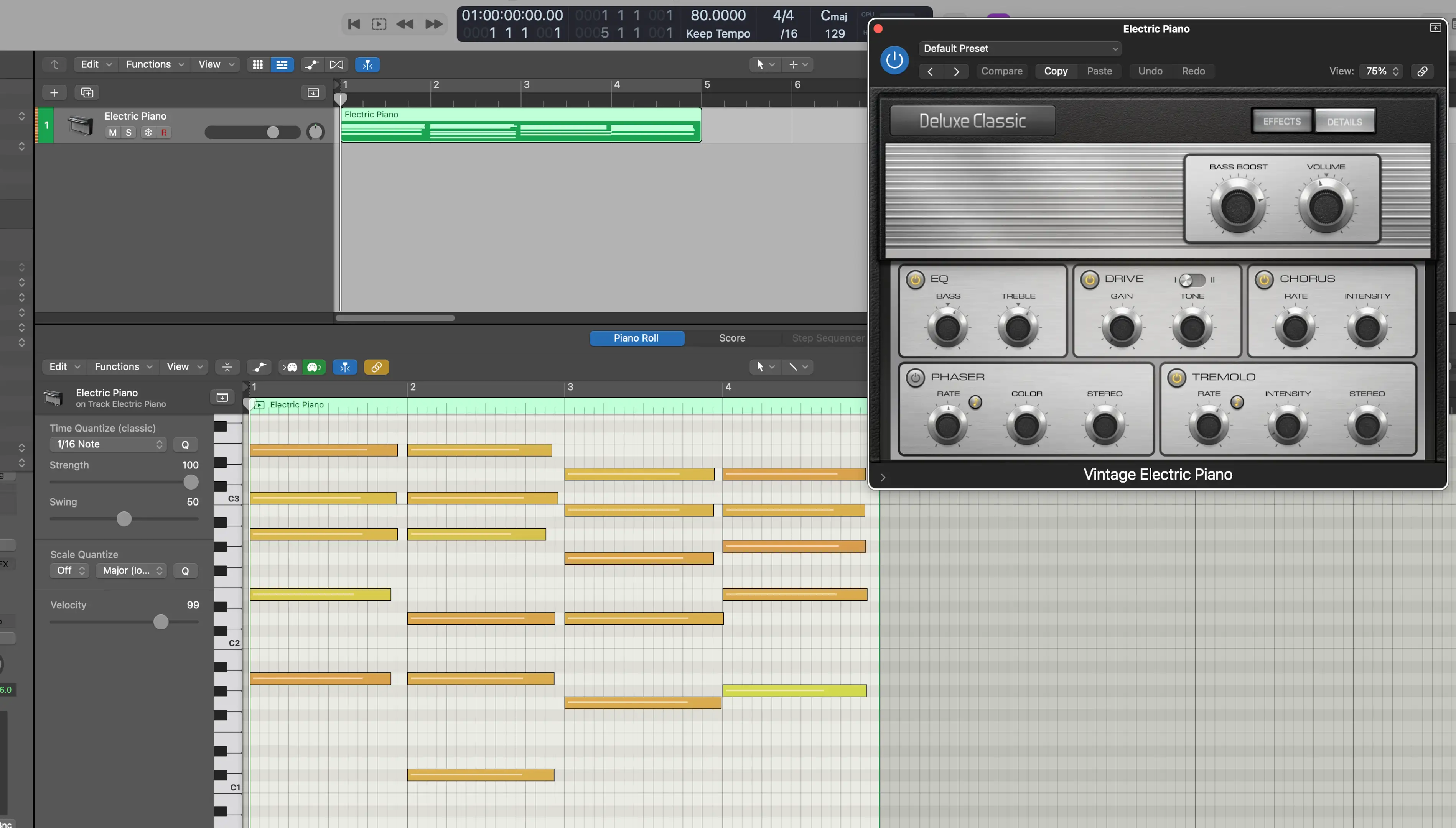
Step 2: Adding Bass and Drums
Next up, I want to add in some foundational elements to the track. The bass (along with the electric piano part) will provide the harmonic backbone, while the drums will give the song some rhythmic grounding.
I'm using stock instrument presets that ship with Logic for the sounds - I can always go back and tweak them later.
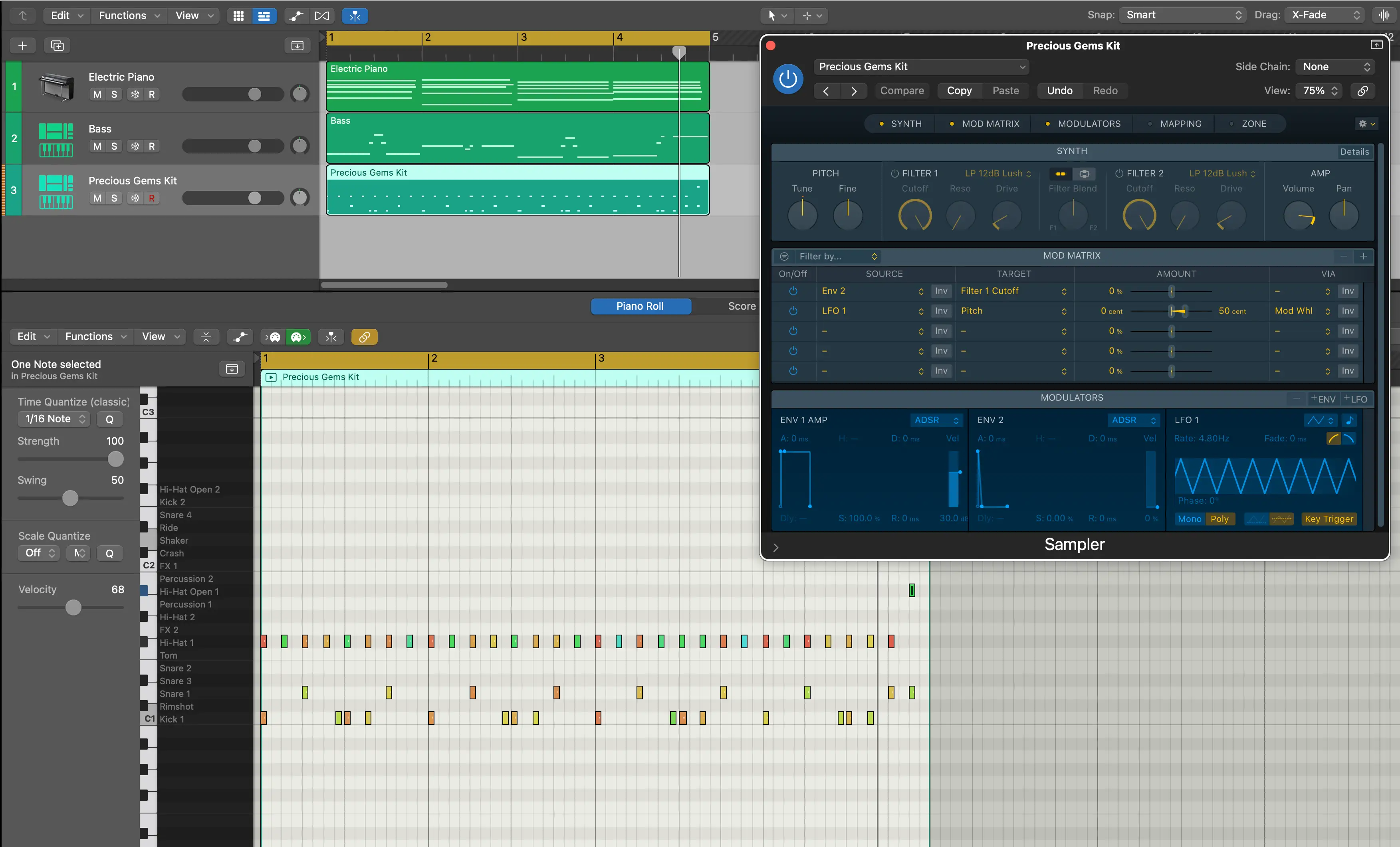
Step 3: Recording Melodies
Now that we've got the basic elements of the track in place, I want to record a melodic element. I'm going for a synth part, but you could use a vocal, a sax sample, or record your own.
Again, I'm using a stock preset here, but I've tweaked the settings slightly so it's not quite as bright. (and because we're still in the land of MIDI, everything can be replaced later).
I've used the mod wheel and pitch bend to give a little more expression to the part. If I do end up changing the sound I'll need to be mindful that these expressions translate to the new patch.
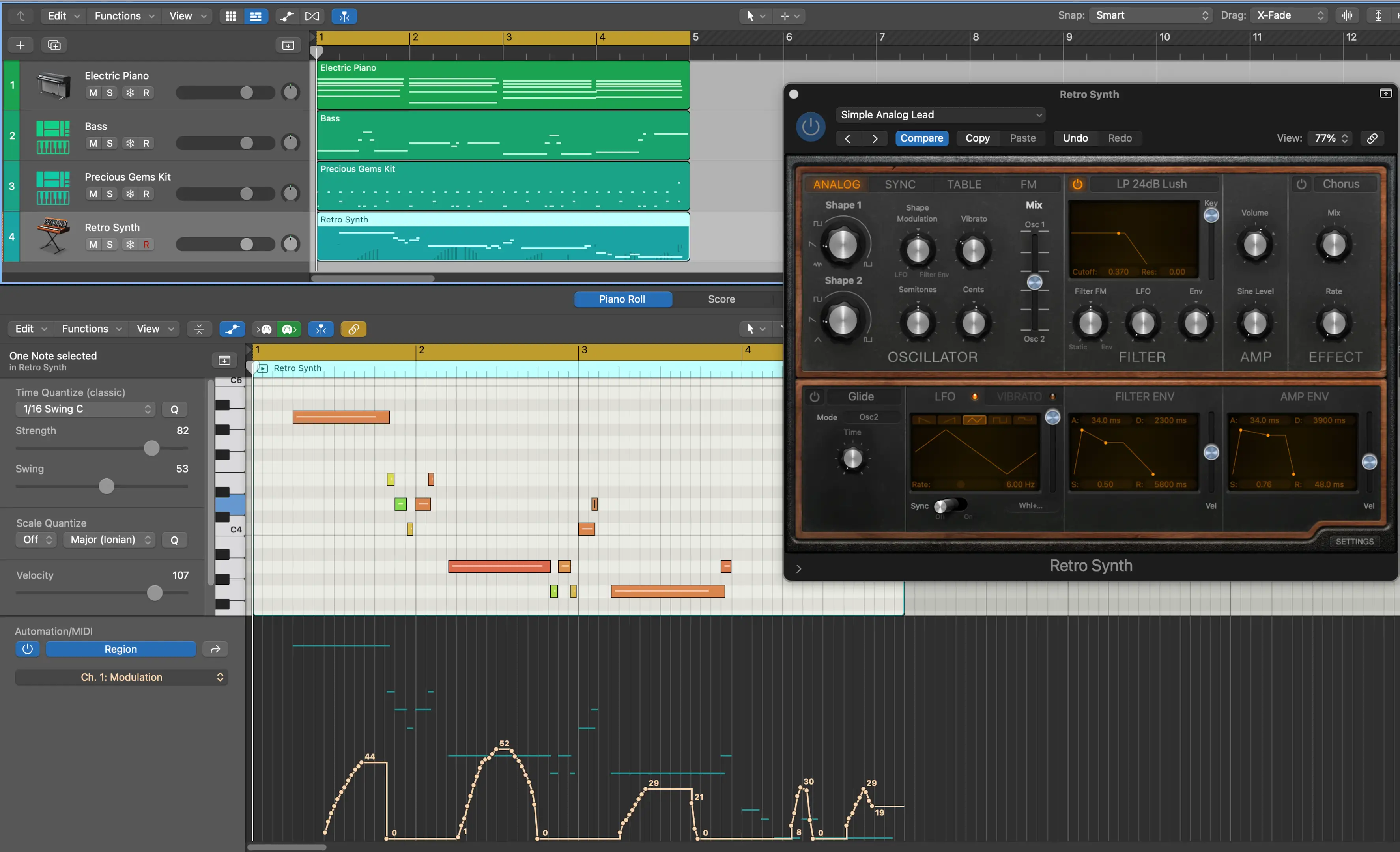
Note that I'm just building up tracks around a loop at the moment. Some producers work this way, while others build songs in a more linear fashion. There's no right or wrong.
Step 4: Adding Effects and Arranging
Things are shaping up! Now the basic ideas are in place and it's time to arrange the piece. To begin with, I'll copy the 4 bar loop I've created multiple times, and create marker regions for the different sections.
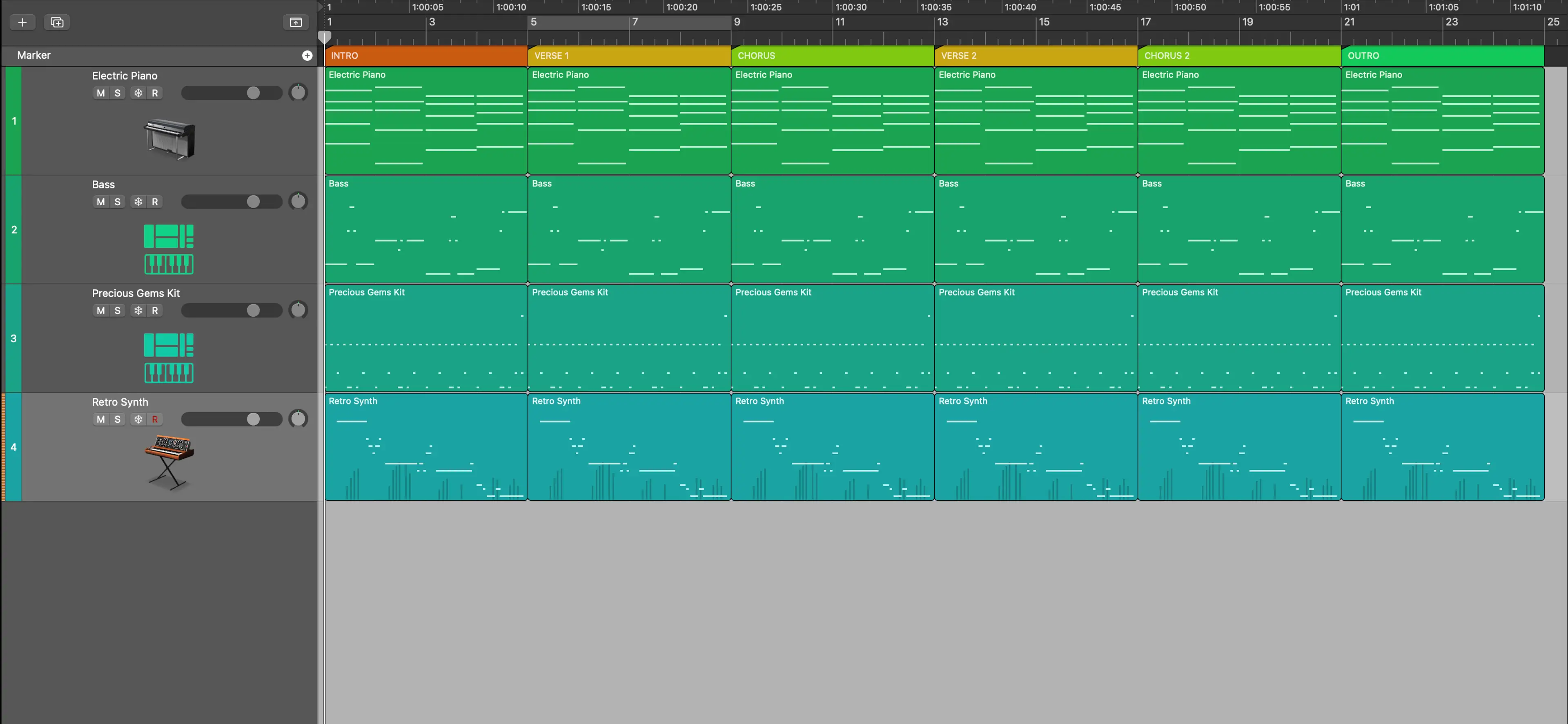
Next I'll start carving out space by muting regions, either in their entirety, or by splitting them up.
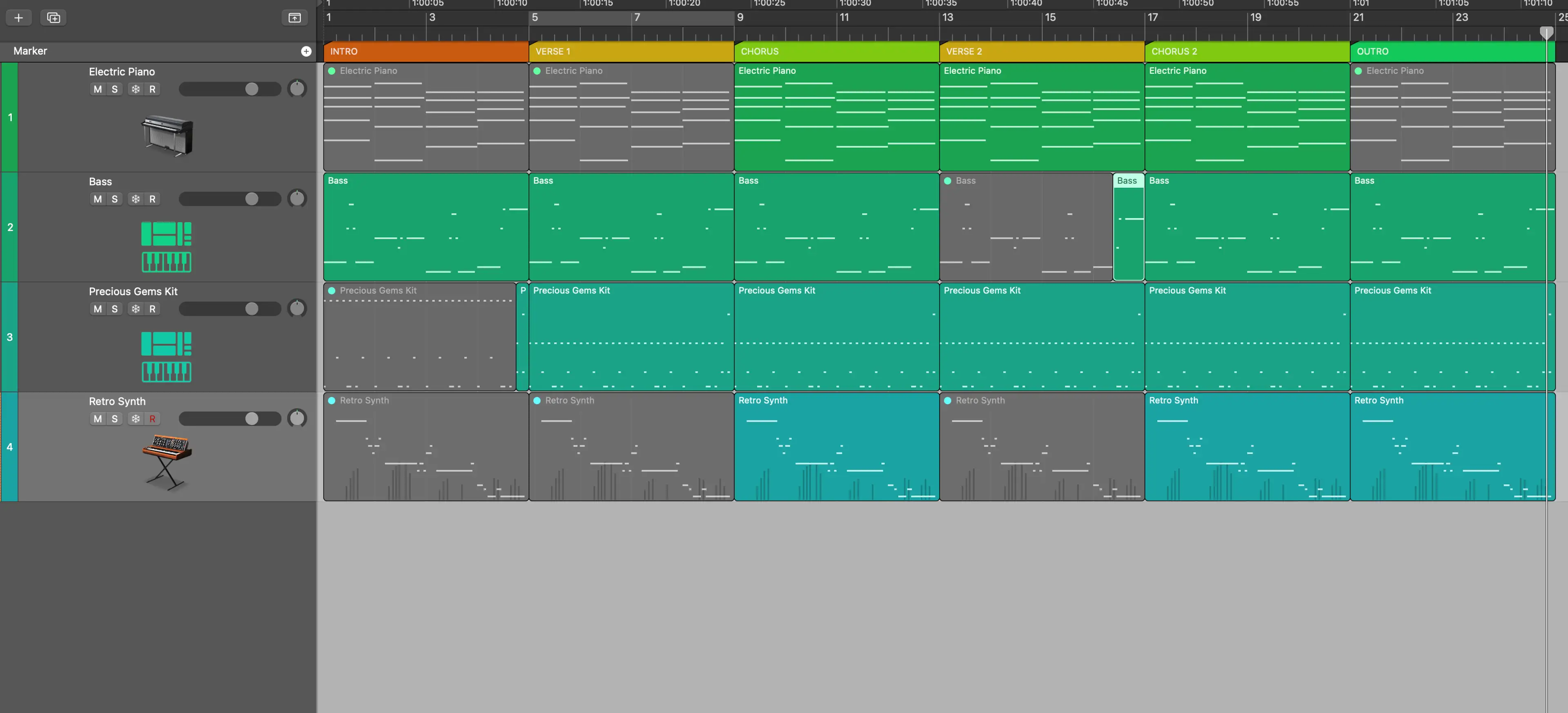
It's possibly the world's shortest song, but you get the picture of how a production can be put together.
Let's add some variety to what's happening by muting the snare in the second verse, and adding a guitar part in the chorus and 2nd verse. I'm using a sample from the included Apple Loops library.
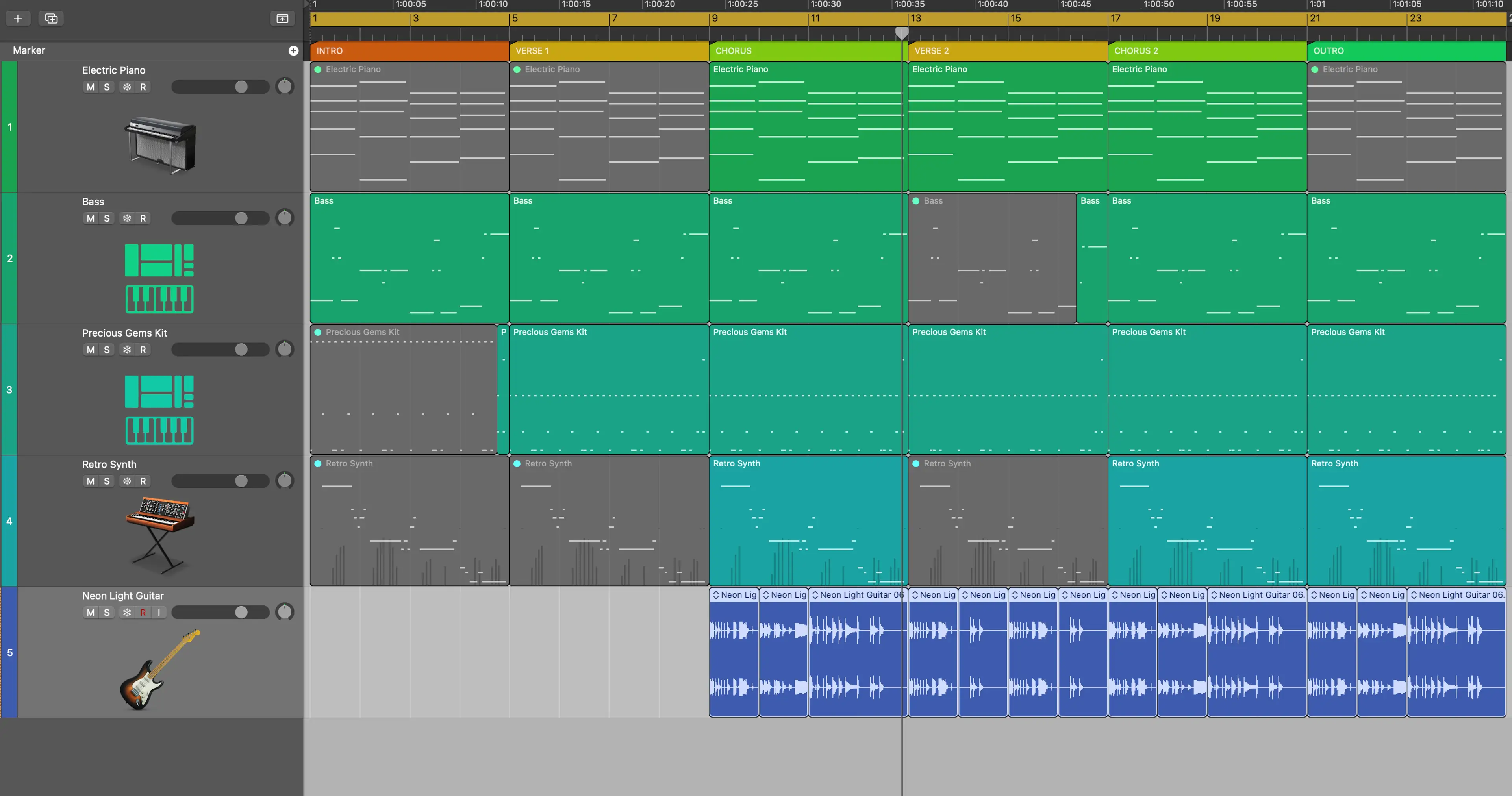
Here's how it sounds at the moment, with zero effects added:
I'll use compression and EQ to clean and tighten up the instruments ( including some sidechain compression on the bass to allow the kick drum to pop out), and add some phase distortion as an insert effect on the electric piano.
This is also the time to add a bit of what I like to call 'fairy dust' - tracks that don't necessarily hold melodies or rhythm, but add a little something extra to the production. I've used a couple of instances of Logic's wundersynth/sampler Alchemy to add some textures, and recorded a shaker part to lift the chorus.
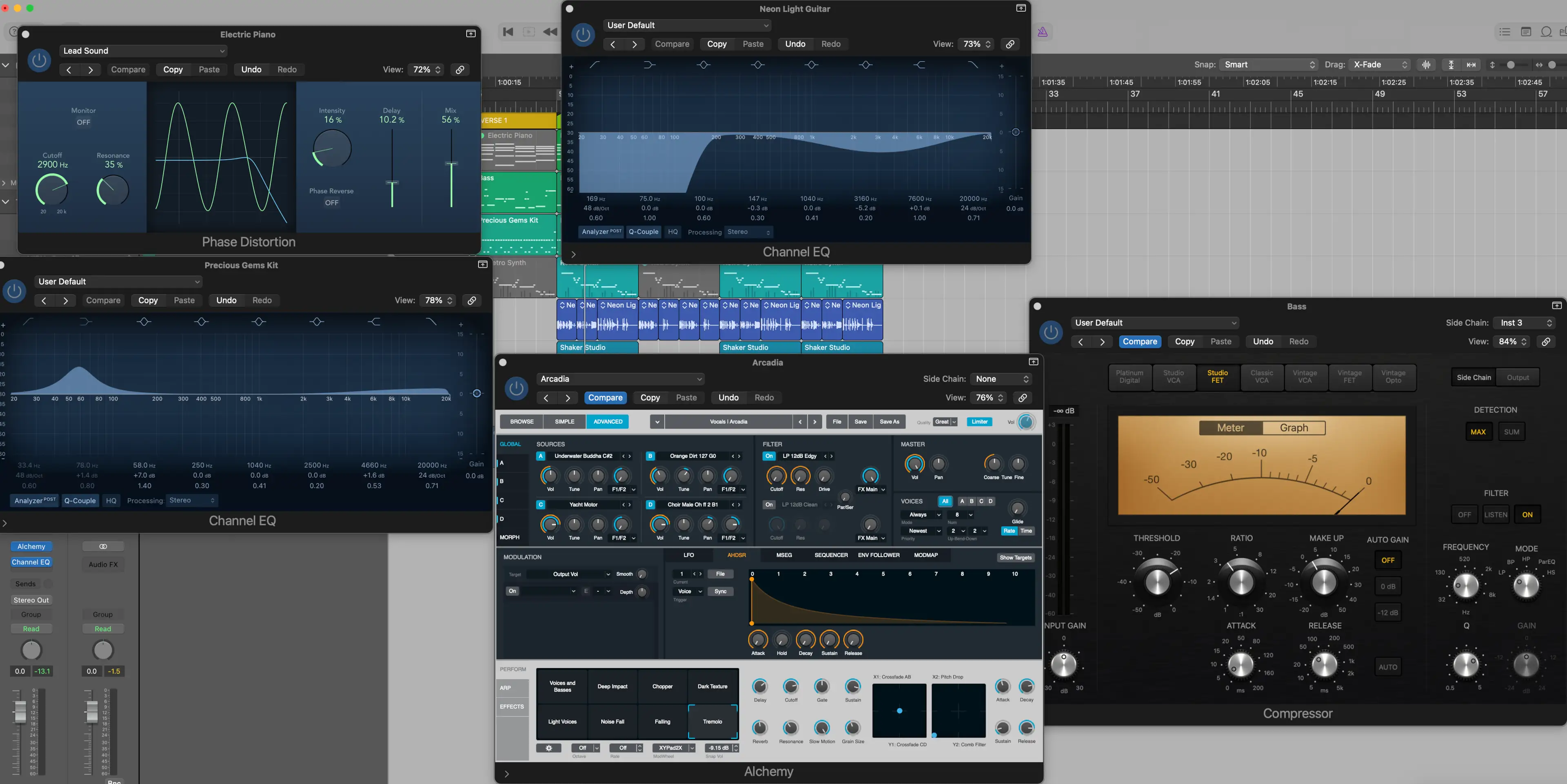
Step 5: Mixing
Mixing is an art form worthy of its own article, and indeed there are many . For now, I'm going to focus on some basic concepts to get things started.
Volume Balance
Before going anywhere on the plugin front, start by adjusting the volume faders to get the levels of the different tracks feeling balanced.
Leave some headroom for the mastering stage, so keep an eye on the overall level coming out of the stereo bus. Ideally you want things to peak at around -6dB.
In this example song, I'll add a fade out on the stereo bus for the outro of the track. Unoriginal, I know, but it's a good use of automation - your best friend in music production.
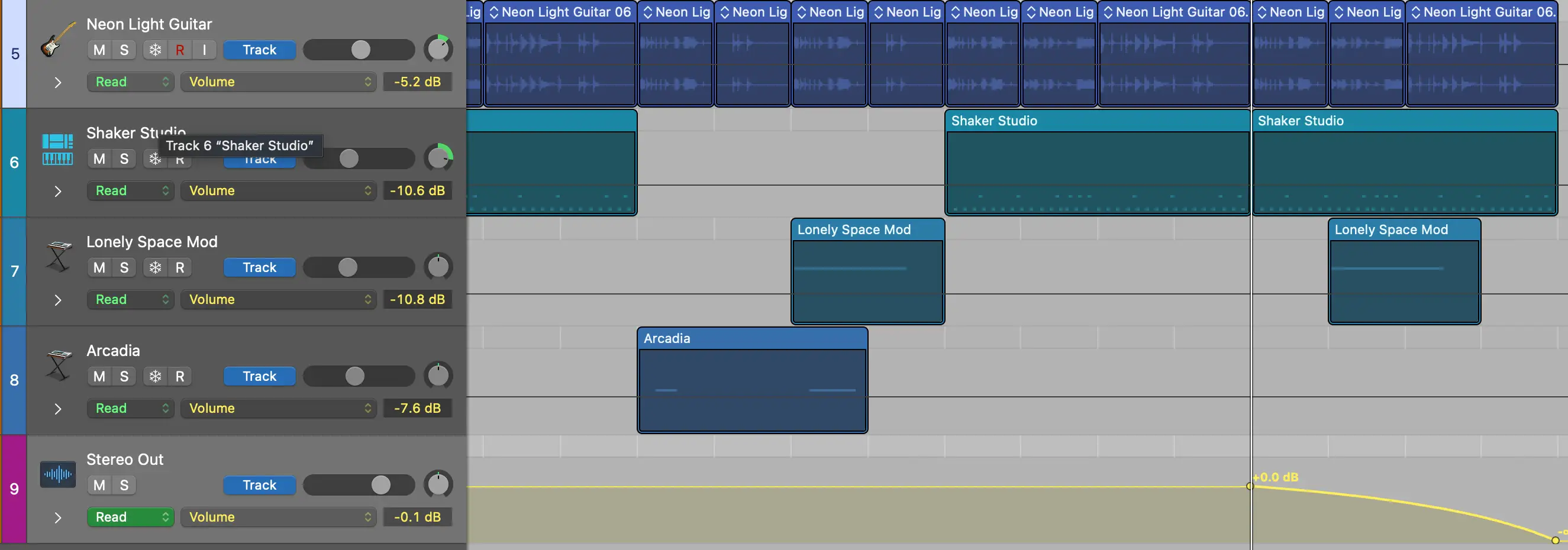
Panning
To give everything some space, I'll spread the tracks across the stereo field. Bass, kick and snare stay center, while the hats get panned slightly to the left (from within the sampler instrument itself), and the shaker goes a little to the right. Panning can create so much space when you're making music, so don't be afraid to use it.
EQ
To keep things uncluttered, it's good to remove muddiness and tame any harsh frequencies by using EQ . Cutting out low frequencies in tracks leaves space for the kick and bass to pop through, while taming harsh frequencies makes things easier on the ear.
Sidenote: I've already cleaned up the instruments in the previous section, so I don't have a lot to do here. There's no right or wrong way to go about it, so long as it gets done.
Reverb + Delay
Things are sounding a little dry and bland at the moment, so I've added some reverb to the piano, guitar, and synth parts. Reverb adds depth and helps a production feel like it's all coming from the same space.
I've also added a little delay on the synth line, for movement. I'm using an aux send for each of these effects, so all the instruments are sharing them. This is a good way of conserving CPU power.
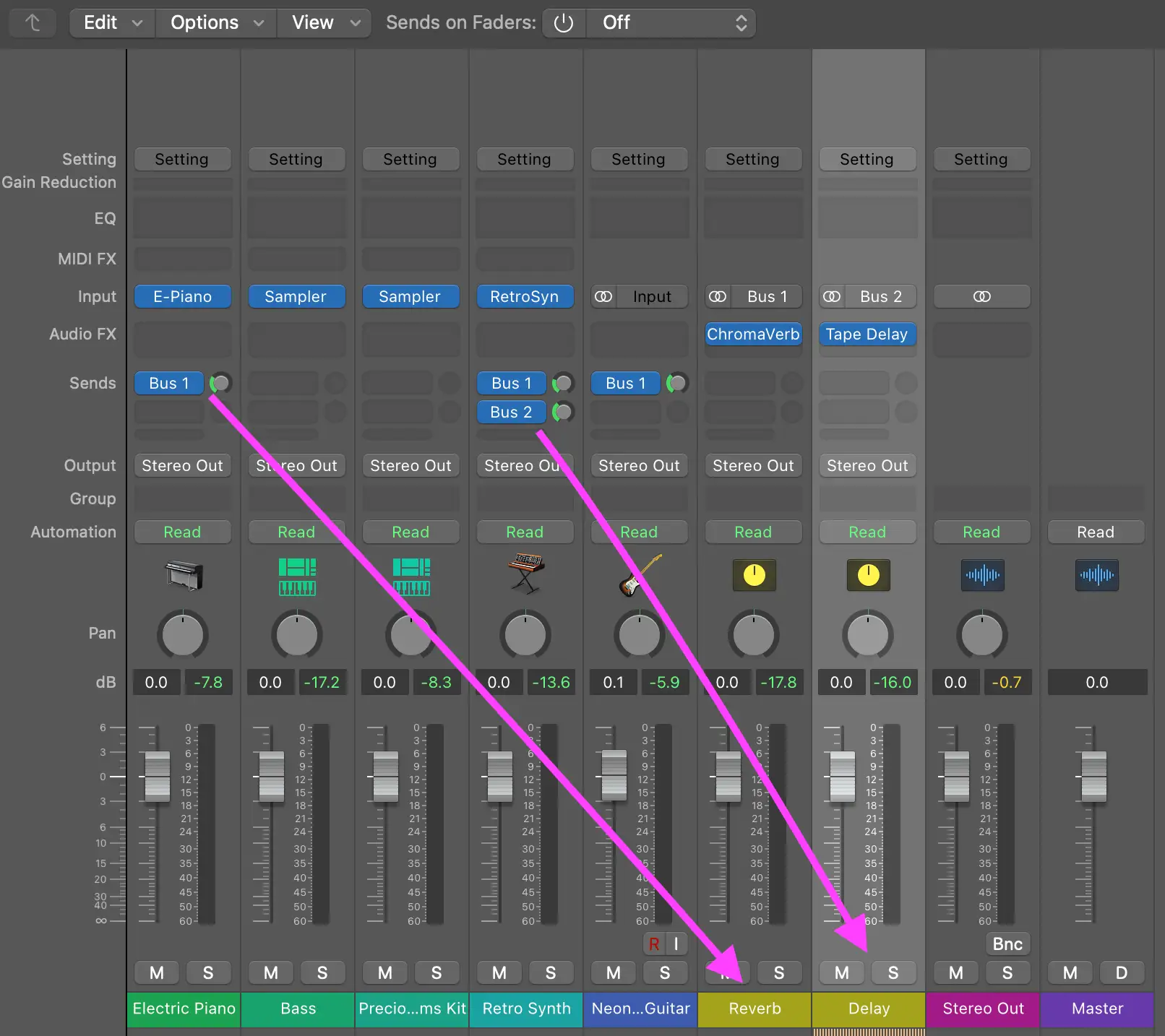
Reference Tracks
I'm not using one here (naughty!) but comparing your songs to reference tracks in a similar genre can be a really helpful way of making sure your music stands up against the competition. It's not about copying ; it's about learning what makes a mix solid.
OK, here's where things stand now.
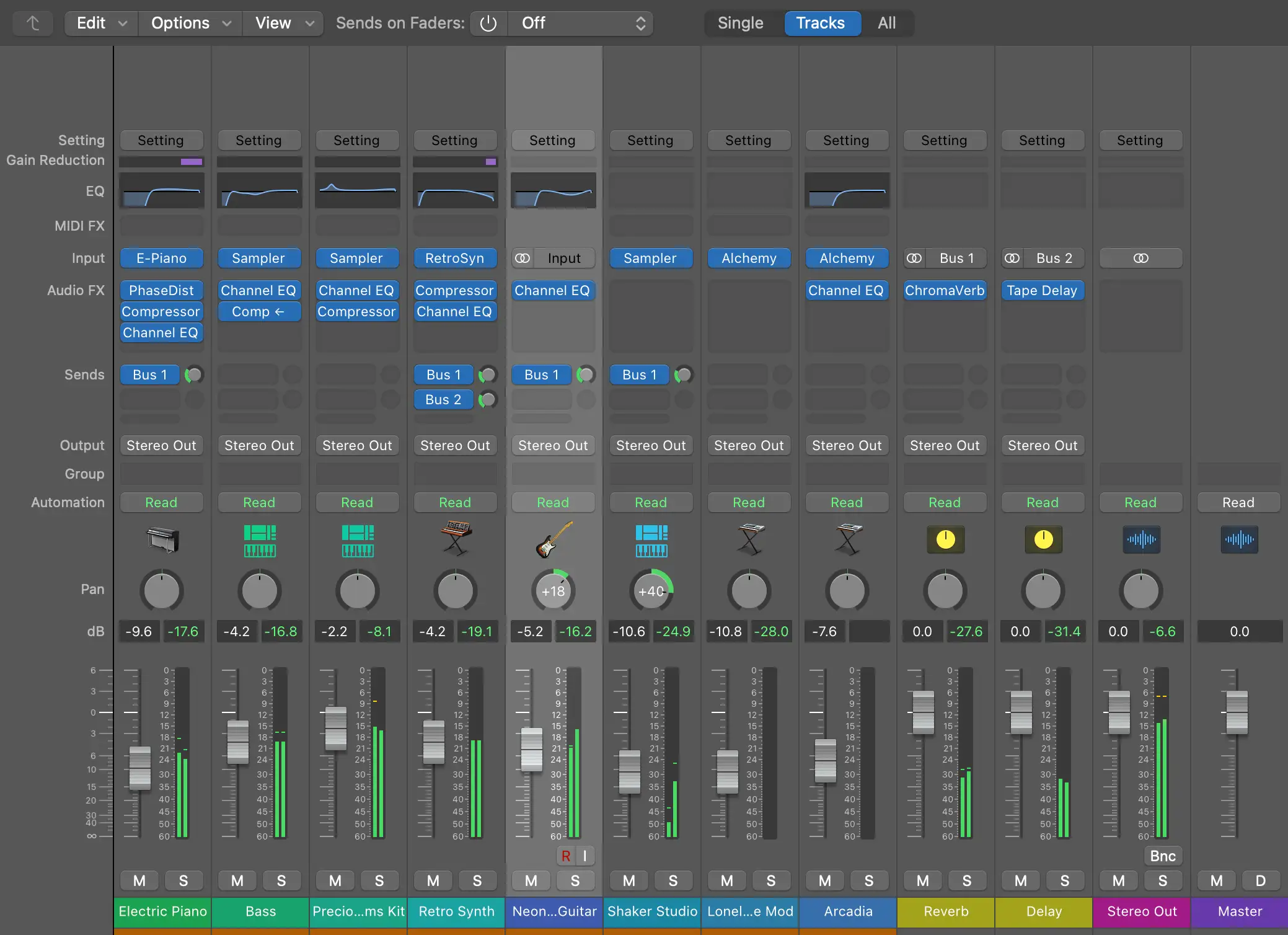
It's a very basic piece of music, and there are many more production techniques that could have been employed to jazz things up. But this example shows how simple music production can be - you just need to dive in!
Mixing and Mastering
While we're here, let's take a moment to talk about mixing versus mastering.
In a nutshell, mixing involves balancing all the parts of a song so it represents the artists vision. Mastering, on the other hand, is adding the final polish to a mix so it sounds great on a variety of playback systems.
Sometimes a music producer will see things through to the bitter end, producing, mixing AND mastering the song. Other times a producer will hand off the session to an engineer for mixing, or mix it herself and let a mastering engineer take the song over the finish line.
Be warned - mixing and mastering are subtle art forms that take a lifetime (or longer) to, ahem, master. You can be a DIY , one-stop producer, but there's also no shame in sharing the load (including using services like eMastered ).
Sound Design and Synthesis
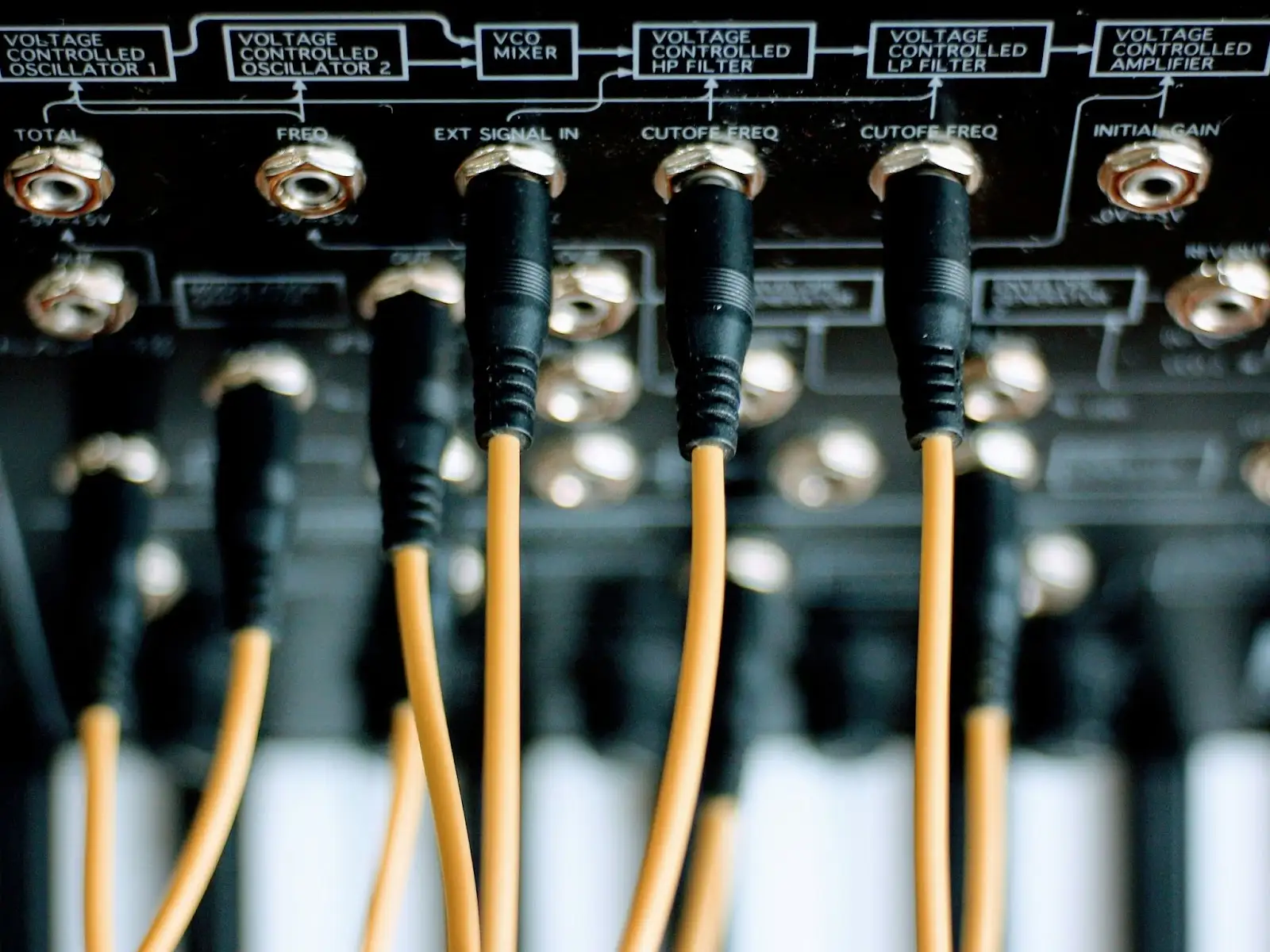
Whether it's a bone-rattling bass, a lush pad, or a weirdo bleep you made from your uncle's Thanksgiving fart, music production starts to feel like magic when you begin playing with the sounds.
Sound design and sound synthesis is a hands-on, experimental process, and one of the most creative (and unique) elements of being a music producer.
Instead of relying solely on synth presets and generic loops (that anyone can get their hands on), a good music producer will learn how to modify, or build from scratch , their own sounds. You don't need to be a synth wizard (Harry) to start playing; just start mucking around - and don't forget to save the ideas you come up with.
The more you play, the more control you'll have over the emotional and sonic character of your tracks. Whatever area of the music industry you're making music for, even having a few go-to custom sounds can make you stand out as a producer.
Developing as a Music Producer
Being a music producer isn’t a fixed state - it’s an ongoing process of learning new tools, mastering technical skills, and discovering creative tricks that keep your ideas flowing.
If you want to be a successful music producer, you’ll also need to stay aware of music industry trends, or better yet, develop a sound that helps set them. Growth doesn’t happen by accident, though. Here’s some practical advice to help you keep leveling up:
It Takes Time
Yes, start making music straight away, but understand that becoming a great music producer takes time. There’s a lot to learn: how to get the most out of your DAW, how and when to use different effects, how to record live instruments, mixing techniques, arranging, sound design - the list goes on.
Challenge yourself to do something creative every day, whether it’s making a beat , experimenting with a synth , or brushing up on some music theory. Making music should be fun, and being a producer is a journey. Combine the two, and you’ll have a bippy little trip.
Develop Your Own Style
When you first start out in music production, it’s all about the magic of creating sounds and putting tracks together. The more music you produce the more you’ll develop a signature style.
It might be a specific ‘sound’ that defines who you are (think Deadmau5, or Skrillex), or a way of working as a music producer - Rick Rubin has collaborated with many artists over diverse genres, but always focuses on a stripped down, emotional approach.
You can't force it, but you can notice which parts of the music production process light you up. Lean into them; that's where your style lives.
Work With What You Have
Not a day goes by without Instagram shoving an ad in my face trying to make me buy yet more gear. The same will happen to you, if it hasn’t already. The thing is, if you get stuck in the eternal cycle of constant upgrades you’ll never master the gear you’ve spent your hard earned moolah on.
Sure, if you’re working on a project that needs a specific sound or effect go ahead and grab it. But don’t get another compressor if you haven’t figured out how to squeeze every ounce from the stock one that shipped with your DAW.
Necessity is the mother of invention, and figuring out how to get the sound you want from the gear you have is where real creativity comes into play.
Show Up
Don’t wait for inspiration - it tends to show up when you do. Commit to making music regularly, even if it’s just a few hours a week. Creativity (and inspiration) is a muscle; the more you use it, the stronger it gets.
As Yoda said: “Do or do not. There is no try.”
Fail Gloriously
Some days your tracks will suck. That’s OK. Everyone makes clunkers. The main thing is to keep going; brush yourself off, open up your DAW, and start making music again.
Celebrate Progress
At the same time, don’t just focus on what’s next. Look back on how far you've come as a music producer. Listen to an old project and recognize how much you've learned. Every new trick, every finished track, it all adds up. Go you!
Stay Curious
Even when you’re not actively producing, you can still be growing. Actively listen to music - how was it made? What makes it work? Read interviews and books on music production. Watch tutorials. Explore unfamiliar genres. Borrow techniques from other producers and try them for yourself.
Collaborate Often
Working with other musicians and artists sharpens your ears, your communication and listening skills, and your instincts. It also gets you out of your own head and into the world , where real growth happens.
Conclusion: Just Do It
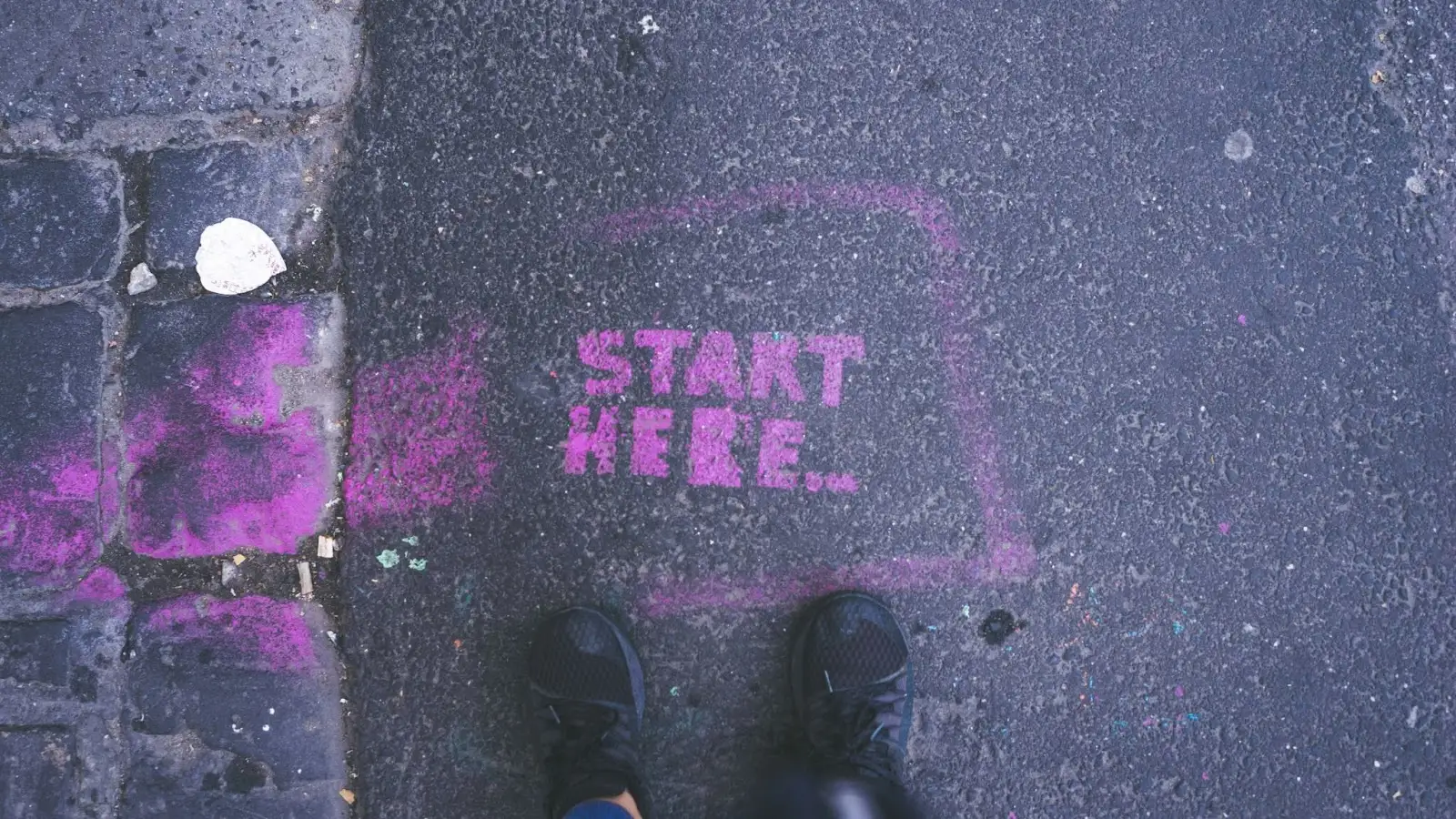
On the surface, the concept of music production can sound complicated, technical, or just downright alien. The truth is, you don’t need to know a ton of music theory or understand how a dynamic EQ works to get started. Every great producer once had no idea what a compressor did - you can learn that stuff along the way. What matters is that you start.
So trust the process; start producing, and keep producing. Get inspired by other producers, explore genres outside your comfort zone, and immerse yourself in all kinds of art - not just music. Embrace your mistakes, celebrate the wins, and when you finish a track... start another one.
Go forth, and maketh the music!


